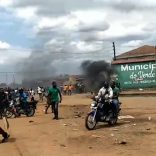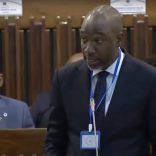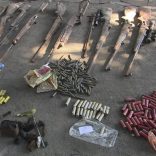Mozambique: Unrest returns to streets - AIM
CNE still changing results in secret, defying the Constitutional Council – after Zim, can this continue? – By Joseph Hanlon

Emmerson Mnangagwa’s margin in Zimbabwe was very close: if 36,320 people had voted for the opposition instead of Mnangagwa, a second round would have been necessary. The Zimbabwe Electoral Commission has come in for criticism, there have been street demonstrations, and the inauguration has been postponed by the courts.
In the 2014 Mozambican elections, the National Elections Commission (CNE) in secret and without explanation gave 41,150 votes extra votes to Frelimo parliamentary candidates. The Constitutional Council (CC) rejected this and gave the votes back to the opposition. For provincial assemblies, the CC rejected secret changes which gave one extra provincial assembly seat to Renamo, and gave it back to MDM. http://bit.ly/2vI51TP
Yet the CNE continues to make secret changes to the results. In the 14 March Nampula by-election this year, the CNE added 572 extra votes – in secret, without explanation, and in total violation of the CC ruling that such changes must be publicly notified. http://bit.ly/2LXYzTr
We have repeatedly asked STAE and the CNE for an explanation, and finally on Friday, five months after the election, we were told that the Nampula city election commission had left out polling stations because the results sheets (editais) did not add up correctly, and the CNE put them back in. Even worse, CNE admitted it had no easily accessible or public record of the changes it made, and said it will be “a lot of work” to discover how the changes were made – although it promised to look for the information.
The issue here is transparency and trust. The CNE can correct “material errors” in the results, but it must do so publicly, and provide a detailed record of corrections made.
Some of the 53 municipal elections on 10 October could be as close as the Zimbabwe result. If the CNE changes the results in secret, in defiance of the CC, and does not keep any record of the changes, what will be the response?
CC ruled CNE failed to obey the law in 2014
In 2014 the CC ruled that the law is clear. There is a pyramid of four counts, with the upper three simply adding up the numbers of level below. At each level, results are published. At the lowest level, each polling station counts its own ballot papers and produces a results sheet (edital); this is the partial count (apuramento parcial). The city or district elections commission then simply adds up the numbers on the polling station “editais” (apuramento intermédio). The provincial elections commission adds up the district and city results (centralisação provincial). The CNE then adds up the provincial results (apuramento geral) which it passes up to the CC for approval.
The Constitutional Council (CC) in 2014 stressed that this is the only permitted way to do the national count. “This is the only data permitted by law for the national results,” said the CC (page 45 of http://bit.ly/CC-acordao21). This procedure is maintained in Title 3, Chapter 4 (art 96-131 ) of the new law, 7/2018, available on http://bit.ly/2LWMTAy.
The CNE can look at the polling station editais, but the CC says if something is wrong it must tell the lower level elections commissions: “If the CNE detects material errors in minutes and ‘editais’ submitted by the provincial elections commission and corrects them, this fact must be notified to the commissions.” In effect, changes must be made public.
The law authorises a “provisional count” (“apuramento provisório”), in which a copy of the results sheet (edital) is sent by the polling station to the CNE in Maputo (art 108) and computerised there. This has in the past been used to release partial and provisional results more quickly to the press. But what has happened in past years is that the CNE has ignored the district and provincial counts and done its own parallel count based on the provisional count, and simply adopted those results. The CC reported in 2014 that “the CNE also affirms in its response that it elaborated the ‘editais’ of the national tabulation on the basis of the minutes and ‘editais’ of the provincial tabulation, as well as data from the Provincial Data Processing Centres and not from the signed provincial minutes and ‘editais’.” This is rejected by the CC, which said that the existence of a parallel count is “reprehensible”.
Despite that ruling in 2014, it does appear that the CNE and STAE (the technical secretariat) simply did their own count for Nampula in March this year. Nothing was said about differences, but on 27 March, we published a table, republished in the attached pdf, with the differences.
Main parties submit candidates
With one day left to go, Frelimo, Renamo, and MDM have submitted their candidates lists for the 10 October elections in the 53 municipalities. In addition a party, a citizens list, and a coalition have submitted candidates: Partido Movimento Alternativo de Moçambique (Alternative Movement for Mozambique, MAMO) will stand in Quelimane, Mocuba and Nampula city; citizens list Solidariedade Cívica de Moçambique (Mozambique Civic Solidarity, SCM) will stand in Maputo city; and the coalition E-Povo has submitted candidates.
The impasse between Renamo and Frelimo over demilitarization delayed the passing of the municipal election laws, which in turn forced the CNE to give parties only 8 days to submit candidates instead of the 22 planned. The deadline is Monday 13 August, and many parties have still to submit candidates – 17 parties, 4 coalitions, and 7 citizens’ groups have registered with the CNE.
Frelimo and Renamo heads of lists, who are the candidates for mayors of the 53 municipalities, are posted here: http://bit.ly/2nwfLRD
Number 2 on the list is also important
The mayor of the municipality is automatically the top person on the list that receives the most votes, and parties have been publicising the names of heads of lists. The rest of the list is not widely publicised, yet the number two is important because they automatically become mayor if the head of the list dies or resigns.
In Maputo, the Frelimo head of the list is the highly respected but 79-year-old Eneas Comiche, who might retire before the end of his five-year term. That would mean Fernando Sumbana Jr, second on the list, would automatically assume the post, but his name is not widely publicised.
By Joseph Hanlon












Leave a Reply
Be the First to Comment!
You must be logged in to post a comment.
You must be logged in to post a comment.